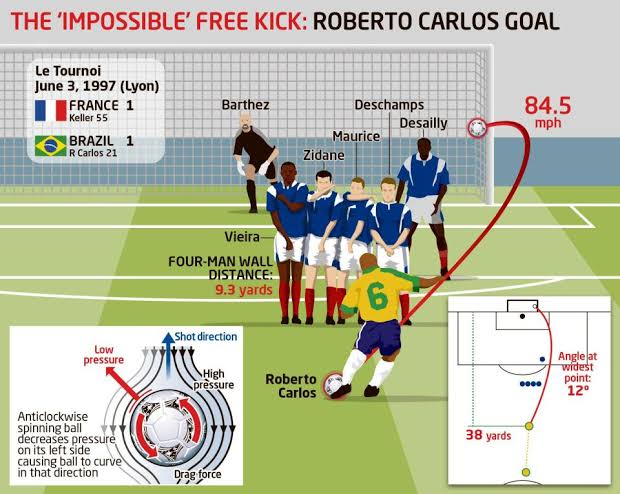Have you ever wondered how a soccer player sets the goal of bending the ball around a five-person wall? The answer is Magnus ’Effect. Bending the ball into the air is not as easy as it seems. There are other theories of physics that make it happen. The effect of Magnus is applied to round or round spinning objects. The result is that the spinning object shifts from one direction to the other. The rotation of the object changes the flow of air in the body and by preserving the force causes the effect of Magnus.
The result is the German philosopher Heinrich Gustav Magnus, who described the result in 1852. Some scientists, such as Sir Issac Newton, described the effect before Magnus, but it was Magnus who was revered.
To see an amazing example of magnus effect just see the following video
Magnus effect and Bernoulli's principle
Does the Magnus Effect depend on Bernoulli’s Principle?
The effect of Magnus is often regarded as a manifestation of Bernoulli's system. According to Bernoulli's law on non-viscous liquids, the pressure decreases when there is an increase in the velocity of the liquid. However, when you consider the example of a rotating ball, with the effect of Magnus, the rotating ball forms a whirlpool of fluid (air) around it and meets the direct force in the direction of movement. Fluid viscosity is considered to be the result of Magnus and Bernoulli's system applies to liquids without viscosity. Therefore, the effect of Magnus does not depend on Bernoulli's system.
How does the Magnus Effect work?
To make the ball turn left while you are walking in the air, you need to get the ball straight in the opposite direction of the clock as you move forward. When you kick with your right leg, you need to kick hard from the inside of your foot so that the ball spins inconsistently with the clock as it moves forward. Basically you need to kick it in the middle. As the ball moves forward, the ball faces the wind from the other side. Now, the wind on the left side of the ball goes in the direction of the spinning ball. This air column moving to the left side of the ball is accelerated and turned to the center of the ball.
The wind on the right side of the ball goes to the side facing the spinning ball. The air column on the right side of the ball goes down and continues straight. The air on the side of the ball does not move in the middle.
So, now you can see that the air movement around the ball is not in line with the actual direction of the ball. There is a net power used in the direction indicated by the arrow in the picture.
Now Newton's third law of motion comes into effect. Newton's third law of motion states that each action has an equal and opposite response.
Like how a rocket quickly goes up when the gas is pressed down. In this case, the force indicated by the violet arrow in this figure causes a counter-force on the opposite side indicated by the pink arrow. So, now there is a change of direction caused by the ball. The process repeats itself to create a continuous rotation of the ball as it progresses.
Applications of Magnus Effect
- The Magnus effect is widely used in sports such as football, golf, cricket, tennis, baseball and many more. This concept is important in understanding the physics behind many football games. To Understand the magnus effect cricket and magnus effect football keep reading .
- Some aircraft are built using the Magnus lift effect using a rotating cylinder in front of the wing, this allows the aircraft to have a lower horizontal speed.
- Used in external ballistics. The part of the wind on the side of the wind causes Magnus' energy to work on the bullet.
Magnus Effect In Sports
Magnus Effect In Football
 |
| Image-Source-Google-steemit.com |
Every person who loves football will definitely know the free kick legend Roberto Carlos Whose 95% Free Kicks Would be direct goals the reason for that is After Carlos sent the ball in the air, the air began to press against Carlos. This means that the side of the ball that is moving towards Carlos would be moving with the wind while the opposite side would be moving past. This imbalance is the key to the effect of Magnus. And thus Magnus Affects in football . If this would be used correctly like Roberto Carlos Then Many Players Would Be Goalscorers .
Magnus Effect In Cricket
 |
| Image-Source-Google-talhaphysicsacademy.blogspot.com |
Swing of cricket ball towards left or right as it moves through the air. This happens when the ball rotates in relation to its vertical axis or because it rotates in the direction of the axis straight to the seam . Fast bowlers swing the ball by making the seam bended 15 ° to 25 ° where the ball is straight so that the smooth part of the ball is on top and in front. In this way the air flows smoothly around the smooth part but becomes turbulent on the other side as it has to jump past the seam. The turbulent wind is at a very high level. So in Bernoulli's theory the pressure on the (aggressive) side is less than in the smooth flow of air so the ball is pressed to the side.
This is also the result of Magnus. This turnaround force is at its highest when the ball speed is around 100 km / hr. But the pace of the ball is going up.








0 Comments
We welcome relevant and respectful comments. Off-topic or spam comments may be removed.